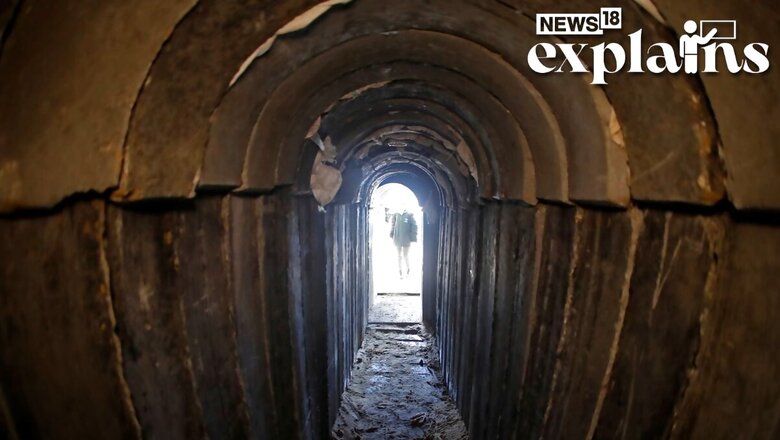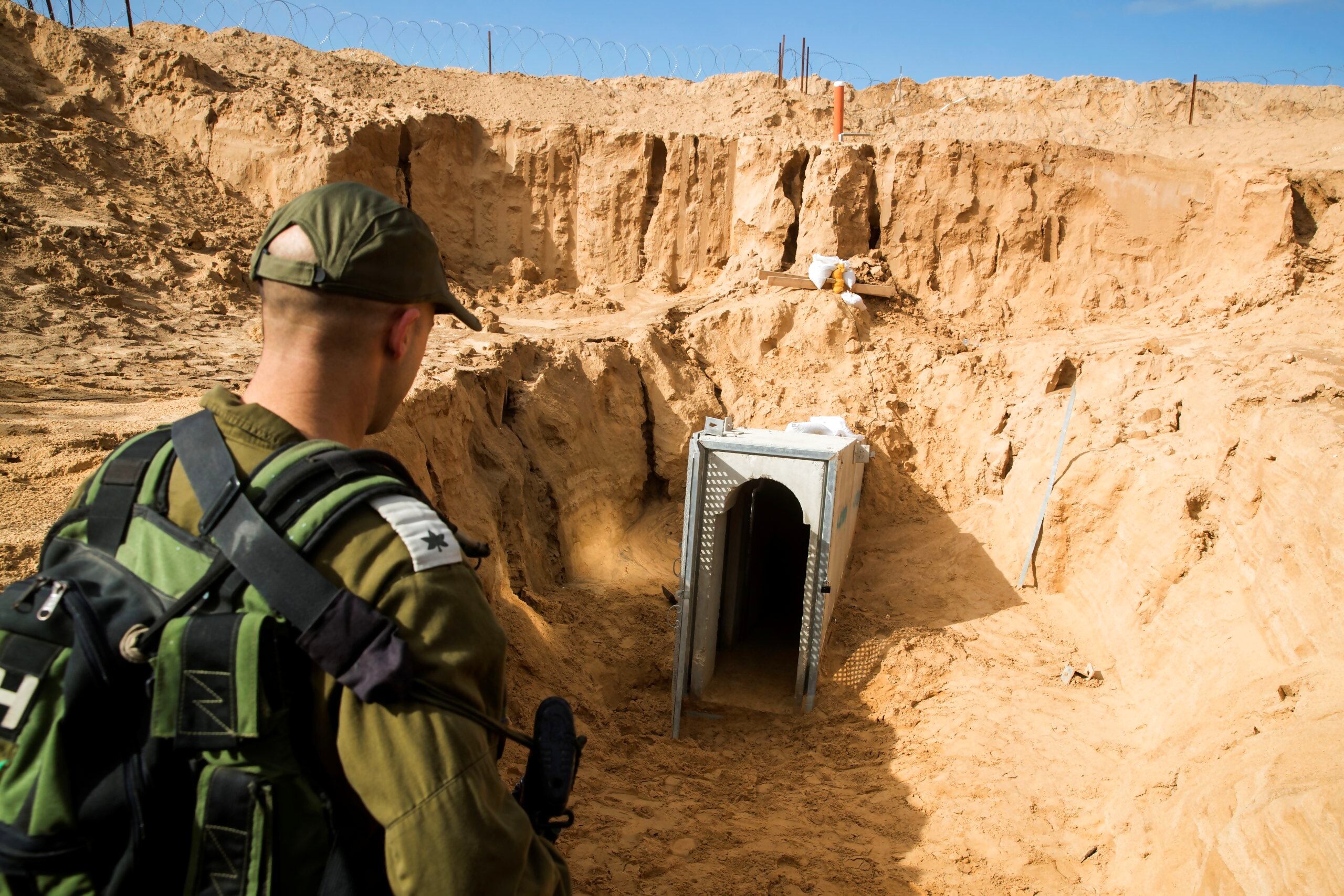
views
The October 7 surprise attack by Hamas on Israel was planned and communicated using a network of hardwired phones built in a network of tunnels underneath Gaza, recent US Intelligence reports have unveiled.
The phone lines in the tunnels allowed Hamas operatives to communicate with one another in secret and cannot be tracked by Israeli officials, according to a report in CNN.
The Israel Defense Forces have referred to the tunnels built by Hamas over the last decades as the “Gaza metro.”
The underground tunnel system used by Hamas have a series of advantages: store rockets and ammunition caches, passage between Hamas controlled areas and smuggle weapons, fighters or other contraband from Egypt to Gaza.
History of the ‘Gaza Metro’ Tunnels
Since the 1980s, the tunnels have been an integral part of the life in Gaza. However, its significance increased after Hamas removed Fatah from the seat of power and severe restrictions were imposed on the movement of goods and people by Israel and Egypt on the territory.
Gaza’s 14-kilometre border with Egypt was burrowed under with hundreds of tunnels used to smuggle fighters, weapons and other contraband — although many have now been destroyed. However, some of the tunnels located across their border with Gaza were destroyed by Egypt.

During the 2014 Gaza war, Palestinian gunmen used tunnels to blindside Israeli forces. Since then, Israel has been developing detection technologies and constructed an underground concrete barrier with sensors to foil attempts to dig across the border.
The passageways have been a mystery for the world forever with very little known about it in the outside world. Israel has repeatedly raised the issue of Hamas operating these tunnels beneath Gaza.
Israel’s army and intelligence became aware about a portion of the network and bombarded it heavily in 2021. However, a large part of the tunnel system remains secret and will make any Israel Defense Forces (IDF) ground operation in Gaza more difficult.
All About ‘Gaza Metro’
The narrow web of streets in Gaza, one of the most populated areas in the world, is doubled underground by a dense tunnel network or the “Gaza Metro”. The labyrinths of tunnel are believed to be 41 km long and 10 km wide. But in 2021, Hamas claimed to have built 500 km of tunnels under Gaza, though it is unclear if the figure was accurate.
But since 2014, Hamas has been digging underground pathways to get around territory it controls. Some tunnels are as deep as 30 or 40 metres below ground, allowing militants to change position away from the danger of strikes.
We have all now heard about how bad #Hamas tunnels are, but what can the @IDF do about them? Fill with cement, seawater, smoke? Bunker busters? I sat down with @RichemondBarak on my #podcast to discuss it all. Have a listen. https://t.co/kXN3Jxk85M— John Spencer (@SpencerGuard) October 20, 2023
Rocket batteries hidden just a few metres beneath the surface can be uncovered with a trapdoor just for the time it takes to fire a salvo.
Hamas “knows its tunnels by heart,” Colin Clarke, research director at the New York-based Soufan Center think-tank said. He added that “some are probably booby-trapped. Preparing to fight in such terrain… would require extensive intelligence… which the Israelis may not have.”
Why are These Tunnels Valuable
Tunnels have been an efficient tool of warfare since a long time. Currently, they offer militant groups like Hamas an edge in asymmetric warfare, negating the technological advantages and advanced military which the Israeli forces have.
The vast network of tunnels has been crucial since the Gaza territory has been under a land, sea and air blockade by Israel and a land blockade by Egypt since 2007 as well.
Hamas has been using the tunnels underneath the Egyptian border for smuggling fuels, weapons and commercial goods by Palestinian-based groups. The tunnels beneath Gaza have also been used to transport people and goods and store rockets and ammunition caches and house Hamas command safe from Israeli aircraft and surveillance drones.
Role in Attacks Against Israel
Israelis have often referred to these as “terror tunnels” and further restricted the entry of construction materials into the Gaza Strip.
In 2006, Hamas captured Israeli soldier Gilad Shalid and killed his two colleagues in a cross-border raid using tunnels, according to a report in Wion. The soldier remained under Hamas control for two years before he was released under a prisoner exchange deal.
In 2013, the Israel Defence Forces discovered a 1.6 km-long, 18m-deep tunnel with concrete roof and walls. The tunnel, which ran from the Gaza Strip to land near an Israeli kibbutz, was found after strange sounds were heard by the residents.
In 2020, Israel discovered a new cross-border tunnel from the Gaza Strip and its military said extended “dozens of metres underground” and into southern Israel.
While Israel relies on bunker buster bombs and Merkava tanks, it has to tackle booby traps while Hamas operatives aware of the underground network use it to strike, hide and escape.
It’s also tough for Israel military to locate the tunnels, which may be under buildings or structures. However, there are several ways to do so, including using radar and other detection techniques that can measure thermal patterns, magnetic signatures and acoustics, according to DW.
Role in Latest October Attacks
The shocking attacks by Hamas which shook Israel earlier this month was a combination of simultaneous attacks via air, water, land and rocket strikes. The Israel’s border with Gaza remains fenced and has sensors installed which can detect movement.
According to experts, the tunnels may have played an important role in the undetected crossing of Hamas operatives into Israel. The fence built by Israel on the border with is 30 feet high and has an underground concrete barrier.
Therefore, the only way Hamas operatives were able to enter Israel undetected would have been using tunnels under the barrier and the fence. Released Israeli hostages have also stated that the tunnels were used to keep them. Yocheved Lifshitz described the “unimaginable hell” of her kidnapping ordeal that included being held in a “spiderweb” of wet tunnels after she was abducted from Israel.
(With inputs from agencies)



















Comments
0 comment